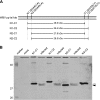Characterization of Bafinivirus main protease autoprocessing activities
- PMID: 21068254
- PMCID: PMC3020504
- DOI: 10.1128/JVI.01716-10
Characterization of Bafinivirus main protease autoprocessing activities
Abstract
The production of functional nidovirus replication-transcription complexes involves extensive proteolytic processing by virus-encoded proteases. In this study, we characterized the viral main protease (M(pro)) of the type species, White bream virus (WBV), of the newly established genus Bafinivirus (order Nidovirales, family Coronaviridae, subfamily Torovirinae). Comparative sequence analysis and mutagenesis data confirmed that the WBV M(pro) is a picornavirus 3C-like serine protease that uses a Ser-His-Asp catalytic triad embedded in a predicted two-β-barrel fold, which is extended by a third domain at its C terminus. Bacterially expressed WBV M(pro) autocatalytically released itself from flanking sequences and was able to mediate proteolytic processing in trans. Using N-terminal sequencing of autoproteolytic processing products we tentatively identified Gln↓(Ala, Thr) as a substrate consensus sequence. Mutagenesis data provided evidence to suggest that two conserved His and Thr residues are part of the S1 subsite of the enzyme's substrate-binding pocket. Interestingly, we observed two N-proximal and two C-proximal autoprocessing sites in the bacterial expression system. The detection of two major forms of M(pro), resulting from processing at two different N-proximal and one C-proximal site, in WBV-infected epithelioma papulosum cyprini cells confirmed the biological relevance of the biochemical data obtained in heterologous expression systems. To our knowledge, the use of alternative M(pro) autoprocessing sites has not been described previously for other nidovirus M(pro) domains. The data presented in this study lend further support to our previous conclusion that bafiniviruses represent a distinct group of viruses that significantly diverged from other phylogenetic clusters of the order Nidovirales.
Figures





Similar articles
-
Characterization of Self-Processing Activities and Substrate Specificities of Porcine Torovirus 3C-Like Protease.J Virol. 2020 Sep 29;94(20):e01282-20. doi: 10.1128/JVI.01282-20. Print 2020 Sep 29. J Virol. 2020. PMID: 32727876 Free PMC article.
-
Characterization of an alphamesonivirus 3C-like protease defines a special group of nidovirus main proteases.J Virol. 2014 Dec;88(23):13747-58. doi: 10.1128/JVI.02040-14. Epub 2014 Sep 17. J Virol. 2014. PMID: 25231310 Free PMC article.
-
Characterization of a bafinivirus exoribonuclease activity.J Gen Virol. 2018 Sep;99(9):1253-1260. doi: 10.1099/jgv.0.001120. Epub 2018 Jul 30. J Gen Virol. 2018. PMID: 30058998
-
The 3C-like proteinase of an invertebrate nidovirus links coronavirus and potyvirus homologs.J Virol. 2003 Jan;77(2):1415-26. doi: 10.1128/jvi.77.2.1415-1426.2003. J Virol. 2003. PMID: 12502857 Free PMC article.
-
Cysteine proteases of positive strand RNA viruses and chymotrypsin-like serine proteases. A distinct protein superfamily with a common structural fold.FEBS Lett. 1989 Jan 30;243(2):103-14. doi: 10.1016/0014-5793(89)80109-7. FEBS Lett. 1989. PMID: 2645167 Review.
Cited by
-
Identification and characterization of Iflavirus 3C-like protease processing activities.Virology. 2012 Jul 5;428(2):136-45. doi: 10.1016/j.virol.2012.04.002. Epub 2012 Apr 24. Virology. 2012. PMID: 22534091 Free PMC article.
-
The Enzymatic Activity of the nsp14 Exoribonuclease Is Critical for Replication of MERS-CoV and SARS-CoV-2.J Virol. 2020 Nov 9;94(23):e01246-20. doi: 10.1128/JVI.01246-20. Print 2020 Nov 9. J Virol. 2020. PMID: 32938769 Free PMC article.
-
Characterization of Self-Processing Activities and Substrate Specificities of Porcine Torovirus 3C-Like Protease.J Virol. 2020 Sep 29;94(20):e01282-20. doi: 10.1128/JVI.01282-20. Print 2020 Sep 29. J Virol. 2020. PMID: 32727876 Free PMC article.
-
Ball python nidovirus: a candidate etiologic agent for severe respiratory disease in Python regius.mBio. 2014 Sep 9;5(5):e01484-14. doi: 10.1128/mBio.01484-14. mBio. 2014. PMID: 25205093 Free PMC article.
-
Mechanism, structural and functional insights into nidovirus-induced double-membrane vesicles.Front Immunol. 2024 Jun 11;15:1340332. doi: 10.3389/fimmu.2024.1340332. eCollection 2024. Front Immunol. 2024. PMID: 38919631 Free PMC article. Review.
References
-
- Adams, M. J., J. F. Antoniw, and F. Beaudoin. 2005. Overview and analysis of the polyprotein cleavage sites in the family Potyviridae. Mol. Plant Pathol. 6:471-487. - PubMed
-
- Allaire, M., M. M. Chernaia, B. A. Malcolm, and M. N. James. 1994. Picornaviral 3C cysteine proteinases have a fold similar to chymotrypsin-like serine proteinases. Nature 369:72-76. - PubMed
-
- Anand, K., J. Ziebuhr, P. Wadhwani, J. R. Mesters, and R. Hilgenfeld. 2003. Coronavirus main proteinase (3CLpro) structure: basis for design of anti-SARS drugs. Science 300:1763-1767. - PubMed
-
- Ash, E. L., J. L. Sudmeier, E. C. De Fabo, and W. W. Bachovchin. 1997. A low-barrier hydrogen bond in the catalytic triad of serine proteases? Theory versus experiment. Science 278:1128-1132. - PubMed
Publication types
MeSH terms
Substances
LinkOut - more resources
Full Text Sources

